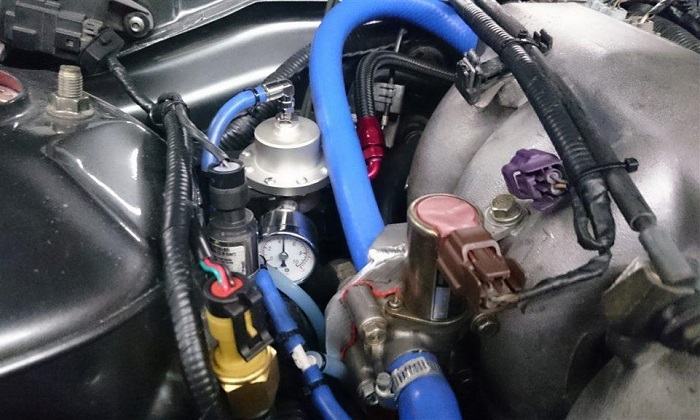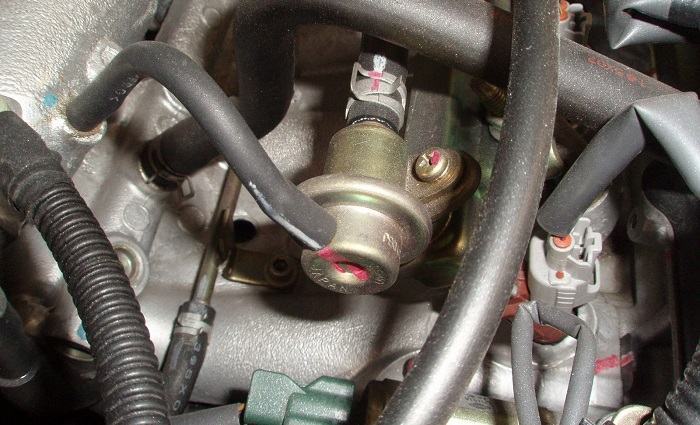by Joshua Thomas
If your vehicle runs rough or does not always start smoothly, the issue can be a faulty fuel pressure regulator as it might be affecting the supply of fuel to the engine's combustion chamber.
But while fuel pressure regulator issues are quite common, they are also easy to miss if you do not know what to look for. And in some instances, you can even mistake a bad fuel pressure regulator for something else.
In this piece, we discuss some of the most common symptoms of a fuel pressure regulator failure and also explain how to replace one if you have to. But first, check out our brief overview of how a fuel pressure regulator works.
Contents

A fuel pressure regulator is tasked with ensuring that the pressure on the fuel system is right for efficient combustion, which means it is neither too strong nor too weak.
While it can come in various forms depending on the car type, it will typically feature a diaphragm attached to a ball-type valve on one side and a spring on the other. The valve side is then connected to the fuel inlet and outlet while the spring side is on the engine vacuum.
The fuel pressure regulator will work by forcing the diaphragm upward or downward depending on the driving conditions. For example, when accelerating it is forced downward which then closes the return line and increases the amount of fuel that the injectors get.

As your fuel pressure regulator starts going bad, there are different symptoms that your car will display depending on the model and the extent of the problem. Knowing these symptoms will allow you to make timely interventions to avoid more serious engine problems. And they include the following.
One of the first symptoms of a faulty fuel pressure regulator is the check engine light turning on because the vehicle's computer is designed to use this light to alert you when there is an issue on the engine.
The light turns on because of the rich mixture condition that the problematic fuel pressure regulator will cause.
But unless you combine this symptom with others below, you cannot tell outright that you have a problem with a fuel pressure regulator since the check engine light can turn on because of several other issues.
If your engine is not getting the right dose of fuel in its combustion chamber or it is not being supplied in the right manner, it will not run smoothly.
The engine can be stalling when you start the car or might make an odd sound which should not happen when the engine is running smoothly.
There should be no hesitation when you press on the gas or even when you decelerate. If you notice any stalling, you should have the fuel pressure regulator checked.
Spark plugs play a crucial role in your vehicle despite their small size, and if you think you might have an issue with your fuel pressure regulator, the spark plug is a good place to start your inspection.
Take out the spark plug and check its condition, and if you notice the end is covered with a thick layer of black soot, this is a good sign that your fuel pressure regulator is faulty.
Blackened spark plugs are a result of oil burning in the engine head, which can be caused by fuel pressure regular failure. And in such a situation, you will need to replace both the fuel pressure regular and the spark plug.
An engine misfire or failure to start completely can also be symptoms of a pressure regulator failure. For the misfire, a bad fuel pressure regulator causes the engine to run rough, and in many instances end up misfiring. Also, the misfire will occur because the air to fuel ratio will not be right.
Besides misfiring, the engine can also fail to start completely. Regardless of how hard or how many times you turn the key or push the ignition button, the engine might still not start.
Because one of the main functions of a fuel pressure regulator is to ensure the right pressure is maintained, a faulty one means that this will not be achieved, and hence making it impossible for the engine to start.
When you have a bad fuel pressure regulator, weaker than normal acceleration will in many instances be your main concern as it is one of the most common symptoms of the problem.
If you press down the gas pedal and notice that the speed increase is not significant enough, you need to check this regulator as this is a sign that the engine is not able to get the right fuel to air mixture.
However, it is also worth remembering that other common engine issues such as faulty or dirty fuel injectors can also cause weak acceleration.
Different components of a vehicle will produce different kinds of noises, but some like the fuel pump make a hardly noticeable sound. Most motorists do not even know what the fuel pump sounds like.
However, if you notice a very loud noise coming from your fuel pump, this can be a sign that you have a faulty fuel pressure regulator.
If the fuel pressure regulator does not allow for normal fuel flow, you can have issues with the fuel pump, which is often manifested as a loud whining sound when accelerating.
But be sure to check the fuel pump thoroughly as the loud noise can also be a symptom of various other problems.
Many motorists pay a lot of attention to the quantity of fuel that their vehicle gobbles up given the ever-increasing fuel prices. But with a faulty fuel pressure regulator, your vehicle's fuel efficiency can reduce significantly.
Hence, if you notice that you are using up more fuel than usual, you need to check the fuel pressure regulator.
When the fuel pressure regulator is faulty, the engine will have to work harder to run the vehicle, which means more fuel will be required.
There is a long list of things that can cause your vehicle to emit black smoke, but a fuel pressure regulator is one of the main ones.
If there is a leak in the fuel pressure regulator or it has internal damage, in many instances it will cause the emission of black smoke in the tailpipe as the fuel combustion will not be properly regulated.

Now that you have some idea on the symptoms to watch out for to know when you have a bad fuel pressure injector, it is only natural to also want to know how to replace it.
And while you can always take your vehicle to the auto repair shop, it is still possible to do it on your own, and here we show you how.
Step 1: Switch Off Vehicle
Although some motorists do not pay a lot of attention to this step, it is still crucial and as important as the others to follow.
Hence, before you start working on your vehicle, you need to switch it off and ensure that the battery terminals are disconnected. But, even just detaching the negative terminal alone should be enough.
Step 2: Disconnect the Fuel Pressure Regulator Vacuum Line
The next step will be to disconnect the vacuum line on the fuel pressure regulator before you can remove it. And when doing this, you should also check for any signs of wear or damage on the line, and if any, you need to replace it.
Step 3: Release Fuel Pressure
Before you can remove the fuel pressure regulator, you will also need to release the pressure. This should be easy as many engines will have a pressure test port which allows you to connect a pressure gauge and use it to release pressure.
Alternatively, use a screwdriver to relief the pressure by tapping the test port, but this method requires extra keenness to prevent accidents.
Step 4: Unscrew and Remove the Old Fuel Pressure Regulator
Now you can unscrew the fuel pressure regulator and detach it from the fuel rail. But, you should also be careful when pushing it from the fuel rail to ensure you do not damage anything as there are some delicate parts here.
Step 5: Screw the New Fuel Pressure Regulator
With the old fuel pressure regulator removed, you can now screw on the new one. Make sure that you have the right replacement part by checking the part number, and also ensure you install it correctly and tighten the screws enough.
Step 6: Clear Out ECU Memory
Because a faulty fuel pressure regulator is an engine problem, it will most likely switch on the check engine light. Hence, after replacing the faulty one, you need to clear the ECU memory to get rid of the error codes.
Here you only need to attach the OBD 2 scanner, allow it to scan then vehicles computer and then reset or clear out the error code that it will display.
Step 7: Take Vehicle for Test Drive
Even if you do everything correctly, you will not be certain the problem is fixed if you do not take the vehicle for a test drive.
Drive it for at least 10 minutes at both low and high speed and check if it runs smoothly and if other symptoms of a bad fuel pressure regulator are manifested.
If the vehicle is okay, the job is done, but if not, you need to check whether you installed the new regulator well or take the vehicle to a professional for further assistance.
It should now be clear that the fuel pressure regulator plays a crucial role in your vehicle's engine, and hence you cannot overlook it as it can affect the overall performance of your vehicle significantly.
Knowing the symptoms to watch out for when you have a bad fuel pressure regulator, which includes things like blackened spark plugs, engine not running smoothly, weak acceleration and emission of black smoke is vital.
With these symptoms in mind and you know how to replace a faulty fuel pressure regulator, you will hardly ever need to worry about this problem as you can easily fix it.
Source
 |
 |
 |
 |

About Joshua Thomas
Joshua Thomas just simply loves cars and willing to work on them whenever there's chance... sometimes for free.
He started CarCareTotal back in 2017 from the advices of total strangers who witnessed his amazing skills in car repairs here and there.
His goal with this creation is to help car owners better learn how to maintain and repair their cars; as such, the site would cover alot of areas: troubleshooting, product recommendations, tips & tricks.
Joshua received Bachelor of Science in Mechanical Engineering at San Diego State University.
Just Car Care